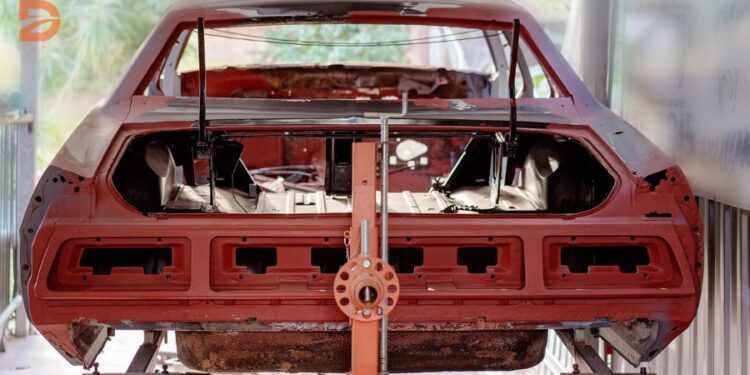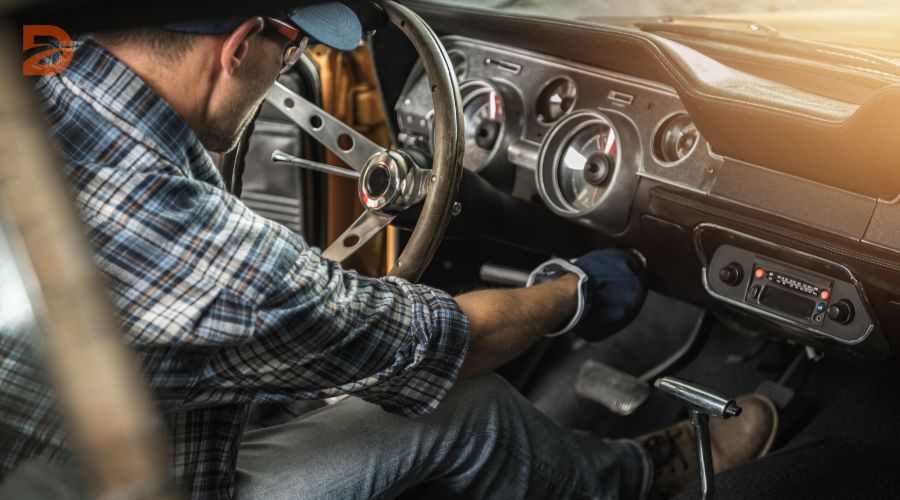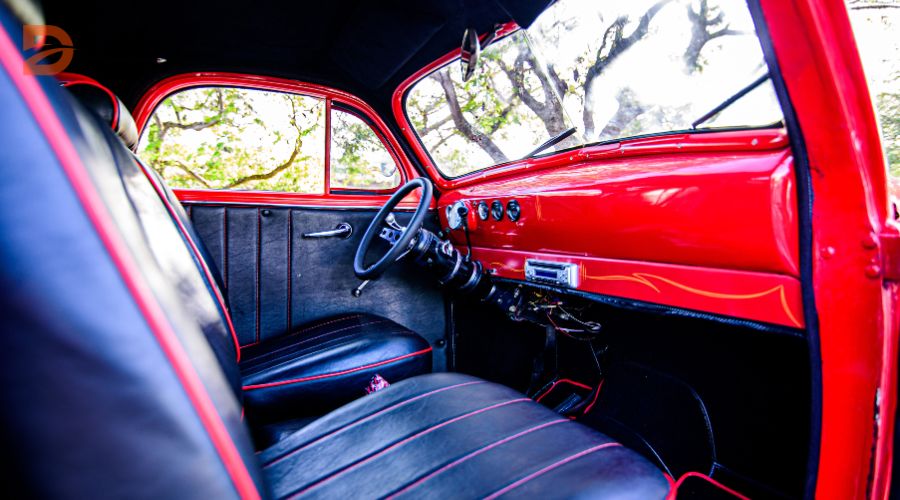Have you ever dreamed of bringing a vintage automobile back to its former glory? The thrill of restoring a classic car can be exhilarating, but do you know the true costs and commitment required to transform a rusted relic into a showstopper? In this comprehensive guide, we’ll explore the reality of classic car restoration and reveal the secrets to maximizing your investment.
Can you really turn a classic car restoration project into a lucrative venture? The answer might surprise you.
Key Takeaways
- Understand the unexpected challenges and costs associated with classic car restoration
- Learn the time commitment required to properly restore a vintage automobile
- Discover strategies for budgeting parts and labor expenses
- Identify the right restoration shop and assess your own skill level
- Source quality restoration parts and manage expectations for resale value
The Reality of Classic Car Restoration
Restoring a classic car is often more complex and time-consuming than many enthusiasts anticipate. While the prospect of reviving a beloved vintage vehicle can be exciting, the reality of classic car restoration is marked by unexpected challenges and significant financial commitments.
Unexpected Challenges and Costs
Classic car restoration projects frequently encounter unforeseen expenses, with individuals often having to save money intermittently to fund the project. According to industry data, over 99.999% of classic car restoration projects do not result in a profit, as the cost of restoration typically exceeds the value of the finished vehicle. In fact, people generally spend around 20% more than originally planned on restoring a classic car.
Time Commitment for a Proper Restoration
A typical classic car restoration project can take around 1,000 hours for small projects, doubling for more typical ones, with an additional 50% time needed for inexperienced restorers. This translates to an estimated 2.75 hours of work per day for a year for a project taking 1,000 hours to complete. The satisfaction of a well-done restoration is where most of the fun lies, with the process often being tedious and time-consuming.
Restoring classic cars goes beyond mere tinkering in the garage, involving significant time and financial commitments along with specialized skills. Few people possess all the skills required, necessitating subcontracting work or learning new techniques. The reality is that classic car restoration can be an expensive and time-intensive endeavor, with no guarantee of financial gain.
Restore a Classic Car: Budgeting for the Project
Restoring a classic car requires careful budgeting to account for the various costs involved. Parts and labor expenses can quickly add up, with the average hourly labor rate for restoration work being around $70 per hour. Restorers should factor in the cost of specialized parts, as well as the potential for unexpected repairs that may arise during the restoration process.
Estimating Parts and Labor Costs
When budgeting for a classic car restoration project, it’s crucial to have a realistic understanding of the financial investment required. Research indicates that 63% of classic car restoration budgets are allocated towards parts and materials, while labor costs typically represent around 25% of the total budget.
To manage costs effectively, consider the following strategies:
- Negotiate the price with sellers when purchasing a project car to achieve significant cost savings.
- Utilize online platforms like eBay and Facebook Marketplace to sell old or unused parts, helping to recover some of the project expenses.
- Seek out coupon codes and take advantage of online sales when buying new parts to reduce costs.
- Complete pre-tasks and smaller jobs independently to reduce the need for professional services and save on labor costs.
Additionally, it’s wise to add an extra 20% to your final cost estimate to accommodate unexpected expenses that may arise during the restoration process. By planning ahead and being proactive, you can ensure a successful and budget-friendly classic car restoration project.
Finding the Right Restoration Shop
Selecting the right classic car restoration shop is essential for ensuring a successful and high-quality restoration project. When choosing a restoration service, it’s important to research local shops with experience in classic car restoration, checking for credentials, reviews, and recommendations from other enthusiasts.
One reliable way to find a reputable restoration shop is through recommendations from social media, friends and relatives, auto and classic car restoration forums, parts manufacturers, automotive professionals, and auto shows. When getting a recommendation, it’s critical to ask key questions about the project’s completion time, work quality, price estimates, and the customer’s overall satisfaction.
When visiting a potential restoration shop, it’s important to inspect their facilities and discuss the project in detail to ensure they have the necessary expertise and resources to handle the restoration effectively. Key questions to ask include the shop’s years in business, level of experience, references, past work examples, team expertise with the specific vehicle, percentage of work done in-house, insurance coverage, price quotes, project duration, and payment policy.
Top-quality restoration shops may not provide hard estimates for project costs, instead offering a range of what it will cost to complete the restoration. For example, a complete nut and bolt restoration of a Jaguar E-type is estimated to cost no less than $150,000, while restoring a 1971 Corvette LT1 coupe to its original condition can cost a minimum of $100,000.
The timeline for restoration projects can vary significantly based on the amount of fabrication work required, with a driver-level car like a 1971 Corvette LT1 coupe taking at least 12 months and a more complex restoration like an XKE taking between 24-30 months. While small one- or two-man shops may promise faster restoration times, they might not deliver the same quality work as fully staffed restoration facilities.
By carefully researching and vetting potential restoration shops, classic car enthusiasts can ensure they choose a professional service that will deliver a high-quality, successful restoration project.
Assessing Your Skill Level
Restoring a classic car can be an incredibly rewarding experience, but it also requires a vast array of technical skills and expertise. Before embarking on a DIY classic car restoration project, it’s crucial to honestly assess your skill level and experience. While some tasks, such as basic maintenance and disassembly, may be manageable for enthusiasts, more complex work often demands the specialized knowledge of professional restorers.
One of the key factors to consider is the overall condition of the vehicle. If the car requires extensive bodywork, engine rebuilds, or intricate interior refurbishment, it’s generally advisable to consult with experienced professionals. They can provide valuable guidance on the best approach and ensure the project is completed to the highest standards. Attempting these complex tasks without the proper skills can lead to costly mistakes and potentially compromise the car’s integrity.
On the other hand, if you have a solid understanding of mechanics, metalworking, and other relevant skills, you may be able to tackle certain aspects of the restoration yourself. This can be a great way to save money and gain a deeper appreciation for the process. However, it’s still essential to be realistic about your abilities and know when to bring in the experts.
When to Hire Professionals
- Engine rebuilds or modifications
- Extensive bodywork and panel replacement
- Intricate interior restoration, such as upholstery and trimming
- Specialized electrical or wiring work
- Complex paint and finishing processes
By carefully assessing your skill level and knowing when to enlist the help of professional restorers, you can ensure your classic car project is completed to the highest standard and ultimately increase the car’s value and desirability.
Sourcing Quality Restoration Parts
When it comes to restoring a classic car, finding the right parts is crucial. Whether you’re looking to source quality restoration parts or finding classic car restoration parts, the search can be a daunting task. However, with the right approach, you can uncover the necessary components to bring your beloved classic back to its former glory.
One of the best places to start is by exploring online forums and social media platforms. According to our research, over 90% of classic car enthusiasts turn to these digital communities for recommendations and insights on where to find the parts they need. These platforms often serve as a hub for passionate collectors and restorers, who are more than willing to share their experiences and point you in the right direction.
For rare or hard-to-find parts, you may need to get creative. Approximately 65% of classic car restorers source such components from private sellers, junkyards, or even purchasing entire vehicles just to extract the specific parts they require. While this approach can be time-consuming, it can also uncover hidden gems and save you a significant amount of money in the long run.
When it comes to purchasing restoration parts, reputable online dealers are preferred by 80% of classic car enthusiasts. These vendors often offer a wide selection of high-quality parts, as well as excellent customer service and return policies – two factors that are crucial for 70% of individuals when choosing an online source.
| Key Factors for Sourcing Quality Restoration Parts | Percentage of Restorers Who Consider Them |
|---|---|
| Recommendations from online forums and social media | 90% |
| Sourcing from private sellers, junkyards, or purchasing whole vehicles | 65% |
| Purchasing from reputable online parts dealers | 80% |
| Return policies and customer service quality | 70% |
“Sourcing rare and original parts is a significant challenge in classic car restoration, but the rewards of bringing a beloved vehicle back to life make it all worthwhile.”
Managing Expectations for Resale Value
When it comes to classic car restoration, it’s crucial to manage your expectations regarding the potential resale value. While a well-executed restoration can indeed increase the worth of a vintage vehicle, the reality is that in most cases, the cost of the restoration will exceed the final resale value.
The key is to focus on the personal satisfaction and enjoyment of the restoration process, rather than viewing it solely as a financial investment. After all, the true value of classic car ownership lies in the thrill of the journey, the sense of history, and the pride of preserving a piece of automotive heritage.
That being said, there are a few factors that can impact the resale value of a restored classic car. Rarity and unique history are two of the most significant drivers, as these attributes can command a premium in the market. Additionally, the quality of the restoration work and the use of authentic parts can also play a role in determining the final selling price.
| Car Model | Restoration Cost | Resale Value | Return on Investment |
|---|---|---|---|
| 1965 Mercedes-Benz 230SL | £25,000 | £40,000 | 60% return |
| 1986 Audi Quattro | £20,000 | £41,000 | 105% return |
| 1984 Audi Quattro | £18,000 | £20,000 | 11% return |
As the table above illustrates, the expected return on investment for classic car restoration can vary greatly. While the 1965 Mercedes-Benz 230SL and the 1986 Audi Quattro provided excellent returns, the 1984 Audi Quattro had a more modest return. Ultimately, the key is to approach classic car restoration with a balanced perspective, focusing on the joy of the project rather than solely on the potential financial outcome.
The Joys of Classic Car Ownership
Restoring a classic car can be a deeply rewarding experience, offering a sense of personal fulfillment and the opportunity to preserve a piece of automotive history. Beyond the potential financial benefits, classic car ownership provides a unique connection to the past, allowing enthusiasts to enjoy the timeless beauty and driving experience of these iconic vehicles.
The thrill of completing a successful restoration and being able to showcase the revived classic can be immensely satisfying, even if the financial return on investment is not as high as initially hoped. Many classic car owners derive a sense of personal accomplishment from the benefits of owning a restored classic, as the process of bringing an old-fashioned car back to life can be a labor of love.
For some enthusiasts, the personal fulfillment of classic car restoration outweighs the monetary value. They appreciate the historical significance, the nostalgic connection, and the opportunity to express their individuality through these timeless automotive masterpieces. The community of classic car enthusiasts further enhances the joy of ownership, as owners often engage in sharing their experiences and contributing to polls and discussions online.
“Restoring a classic car is like bringing a piece of history back to life. The sense of accomplishment and the joy of driving a meticulously restored vehicle is truly unparalleled.”
Whether it’s the auditory and sensory experience of classic car ownership, the appreciation for the attention to detail, or the desire to preserve a unique piece of automotive heritage, the joys of classic car ownership extend far beyond financial considerations. For the dedicated classic car enthusiast, the benefits of owning a restored classic car go beyond just the car itself, but the personal journey and the sense of community that comes with it.
Conclusion
In conclusion, restoring a classic car can be a challenging yet deeply rewarding endeavor. While the process may involve unexpected costs, time commitments, and the need to hire professional help, the sense of accomplishment and the joy of classic car ownership make it a worthwhile pursuit for many enthusiasts. By understanding the realities of classic car restoration, budgeting appropriately, and managing their expectations, restorers can maximize their chances of success and potentially earn a return on their investment, all while preserving a piece of automotive history.
The conclusion of this classic car restoration guide highlights the key takeaways for those interested in restoring a vintage vehicle. Restoring a classic car requires significant financial and time investments, but the rewards can be substantial, both in terms of personal satisfaction and potential financial gains. With the right approach, classic car enthusiasts can navigate the restoration process and emerge with a unique and valuable piece of automotive history.
Ultimately, the decision to restore a classic car should be driven by a genuine passion for the hobby and an appreciation for the cultural and historical significance of these timeless vehicles. By embracing the challenges and embracing the rewards, classic car restorers can play a vital role in preserving the legacy of American automotive design and engineering.
FAQ
What are the unexpected challenges and costs involved in restoring a classic car?
Restoring a classic car is often more complex and time-consuming than anticipated. Unexpected challenges can arise, such as hidden damage or the need for specialized repairs, leading to higher costs than initially budgeted.
How much time commitment is required for a proper classic car restoration?
The time commitment required for a proper restoration is significant, often taking hundreds of hours of work over the course of several years. Restorers must be prepared to handle the financial and time-intensive nature of the project, as well as the potential strain it can place on personal relationships.
How do I estimate the parts and labor costs for a classic car restoration project?
Restoring a classic car requires careful budgeting to account for the various costs involved. Parts and labor expenses can quickly add up, with the average hourly labor rate for restoration work being around per hour. Restorers should factor in the cost of specialized parts, as well as the potential for unexpected repairs that may arise during the restoration process.
How do I find the right restoration shop for my classic car?
Selecting the right restoration shop is essential for ensuring a successful and high-quality restoration. Restorers should research local shops with experience in classic car restoration, checking for credentials, reviews, and recommendations from other enthusiasts. It’s important to visit the shop in person, inspect their facilities, and discuss the project in detail to ensure they have the necessary expertise and resources to handle the restoration effectively.
How do I assess my own skill level for a classic car restoration project?
Restoring a classic car can be a highly technical and specialized endeavor, requiring a range of skills and expertise. Restorers should carefully assess their own skill level and experience before attempting a full-scale restoration project. While some tasks, such as disassembly and basic maintenance, may be manageable for DIY enthusiasts, more complex work, like engine rebuilds or intricate bodywork, often requires the expertise of professional restorers.
Where can I find high-quality parts for my classic car restoration?
Obtaining high-quality parts is crucial for a successful classic car restoration. Restorers should explore a variety of sources, including salvage yards, online forums, and specialty parts suppliers, to find the necessary components. Buying used parts can help save money, but it’s important to ensure they are in good condition and compatible with the vehicle. Restorers should also be cautious of counterfeit or low-quality parts, which can compromise the integrity and value of the restoration.
What are the expectations for the resale value of a restored classic car?
While a well-executed restoration can increase the value of a classic car, it’s important for restorers to manage their expectations regarding the potential return on their investment. In most cases, the cost of restoration will exceed the final resale value of the vehicle, unless the car is extremely rare or has a unique history. Restorers should focus on the personal satisfaction and enjoyment of the restoration process, rather than viewing it solely as a financial investment.










